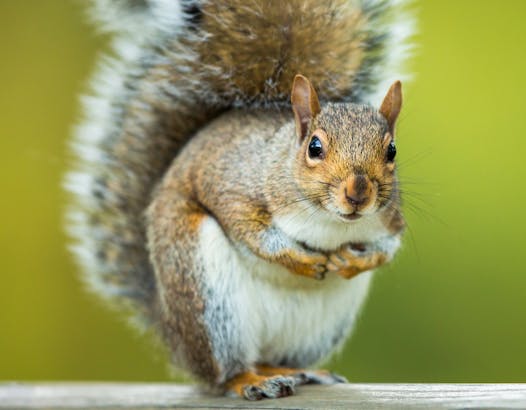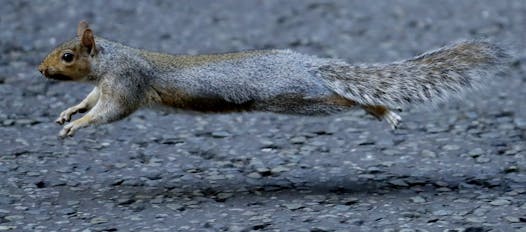When you're weary of the news, or stalling on chores, or waiting for the coffeemaker to produce its Elixir of Life, you may find yourself staring out the window these days and smiling. Even laughing.
It's the squirrels, of course, going nutso this time of year as they prepare for a long winter's snack.
Their frenetic activity captivates those who've imagined leaping among tall trees, and validates those who stash chocolate around the house.
So here's a roundup of all things related to these romping rodents. Because right about now, doesn't the world seem a little squirrelly?
Taking the WABAC Machine to Minnesota
"The Rocky and Bullwinkle Show," a cult cartoon in the 1960s, was set in Minnesota, where its hero, Rocket J. Squirrel, lived in the town of Frostbite Falls (think International Falls) with his moose buddy, Bullwinkle.
Rocky's days were spent thwarting the schemes of Cold War-esque villains Boris Badenov and Natasha Fatale, often using flying skills he learned at Cedar Yorpantz Flying School (say it out loud.)
Like a good Minnesotan, Rocky's most earnest outburst was "Hokey smokes!"
Photobombs away!
When Minnesotans Melissa and Jackson Brandts vacationed in Banff, Alberta, a few years ago, their tourist selfie (taken with a remote control) was hilariously photo-bombed by a squirrel.
The Brandtses sent the shot to National Geographic weekly for a photo contest. The rest is viral history.
Online voting soared. A tourism board set up Twitter and Facebook pages for the "Banff National Park Squirrel," getting more than 80 million hits within a few weeks. Now a Squirrelizer iPhone app lets you insert the squirrel's image into any photo.
Nutty.
How do they do it?
A squirrel spirals up a tree with dizzying speed, then skitters toward the tippity-tip of a branch, which sags into the void as the squirrel knocks down some acorns.
Then the squirrel nonchalantly leaps (nooo!!!) to another branch that seemingly materializes under its paws.
How do they do it? It helps that they can rotate their ankles 180 degrees, pointing their hind paws backward so they can grip the tree bark while descending headfirst.
Wanna see something cool? Wisconsin cinematographer Neil Rettig once filmed a segment for the 2012 National Geographic miniseries "Untamed Americas," showing a squirrel evading a predatory hawk.
It's amazing.
Hawk & Squirrel Sequence from Nat Geo's "Untamed Americas" from John Benam on Vimeo.
No fat-shaming here
At the University of Minnesota Duluth, three researchers are studying whether squirrels hold the key to weight loss. (Actually, they're studying what we call striped gophers, but which are in fact 13-lined ground squirrels.)
The rodents have lots of brown fat, which biologist Matt Andrews has called "nature's fat-burning machine."
These hibernating ground squirrels draw upon stored "white fat" for fuel in winter. But with spring, they burn their brown fat, which boosts their body temperature from 42 to 98 degrees in less than three hours. Because brown fat burns calories incredibly fast, researchers wonder if a genetic component could lead to a drug to boost fat-burning in humans, maybe even coaxing white fat cells to help out.
Which would be a lot easier than burning calories by climbing trees.
Cagey little buggers
Squirrels don't just bury an acorn and come back when they're hungry. They might bury the seed, dig it up, rebury it elsewhere, then dig it up again, according to the scientific journal Animal Behaviour.
Squirrels may do this to deter theft, in case another squirrel was watching. When squirrels are certain that they're being scoped out, they'll even dig a hole, pretend to bury an acorn, then cover it over, all the while keeping the nut hidden in their mouth.
"Deceptive caching involves some pretty serious decisionmaking," researchers said. "It meets the criteria of tactical deception, which previously was thought to only occur in primates" hiding their Halloween candy.
(OK, we added that last part.)
You're blushing
Q: Are squirrel hair cosmetic brushes really made from squirrel hair?
A: Yes, they are.
Bon appetit!
A few years ago, the Chicago Reader published "Chicken of the Trees," a lengthy look into why eating squirrel fell into disfavor and why we should consider eating "alley-fattened wild caught game."
Spurred by revenge after finding his garden tomatoes ravaged by squirrels, the author made a squirrel burgoo, a paté from the organs, and braised the heads in vegetables and sherry.
"A friend demonstrated with a nutcracker the proper technique for extracting a squirrel brain from its cranial cavity, and a half-dozen of us popped them into our mouths. They looked like oversize walnuts and tasted slightly creamy, almost like a soft, roasted chestnut."
Now! No! No, now!
Why do so many squirrels get hit by cars?
We turn to Richard W. Thorington Jr., curator emeritus of mammals at the Smithsonian's National Museum of Natural History, home to more than 30,000 squirrel specimens.
In "Squirrels: The Animal Answer Guide," he says that their ability to dart back and forth is a mixed blessing. In the wild, darting helps to outmaneuver predators. But on the street, going to and fro only increases the risk of colliding with one of four tires.
Thorington contrasts this with the "straight-line, mad-dash strategy of cats, which is a far more successful way to avoid automobiles."
Over time, smarter survivors may learn to cross streets on overhead wires or via flanking trees.
Slow learners suffer an obvious fate: While adult squirrels can live five to 10 years in the wild, most squirrels die in the first year of life.
A diner that looks like a pumpkin
Carved pumpkins are supposed to look scary, but a face half-gnawed by a local squirrel is positively ghoulish. How to repel these rodents?
Suggestions include spritzing pumpkins with pepper spray; coating them with petroleum jelly; placing them on a bed of dog hair; shellacking them with hair spray or clear spray paint; or …
We could go on, which tells you there's no guaranteed fix.
Bright-eyed and bushy-tailed
Squirrels are members of the family Sciuridae, from the Greek skiouros, which means shadow-tailed, for their bushy appendages. According to McGraw-Hill's Dictionary of American Slang, squirrels likely inspired the phrase "bright-eyed and bushy-tailed" because they look alert and ready for anything.
Even winter.
Oregon's Sports Bra, a pub for women's sports fans, plans national expansion as interest booms
Retrial of Harvey Weinstein unlikely to occur soon, if ever, experts say
Today in History: April 27, Magellan killed in the Philippines
The summer after Barbenheimer and the strikes, Hollywood charts a new course



